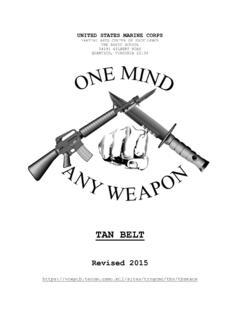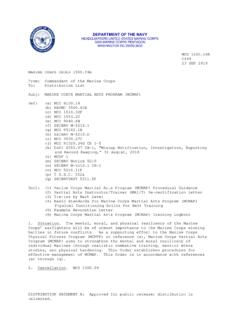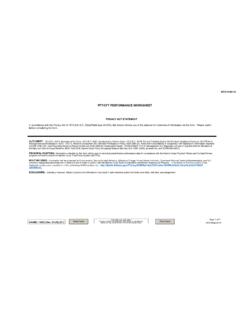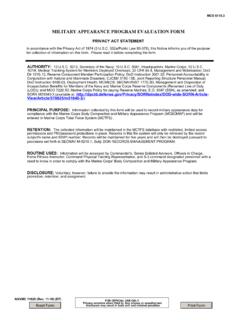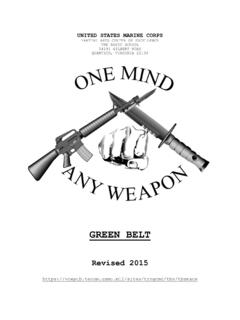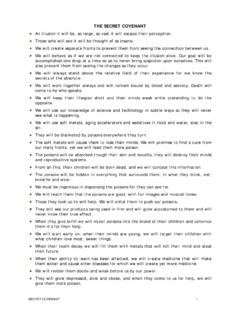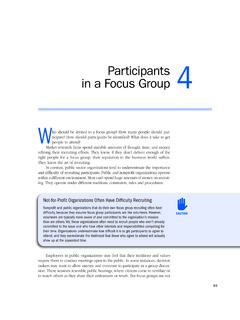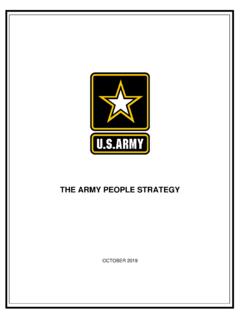Transcription of GRAY BELT - United States Marine Corps
1 United States Marine Corps MARTIAL ARTS CENTER OF EXCELLENCE THE BASIC SCHOOL 24191 GILBERT ROAD QUANTICO, VIRGINIA 22134 GRAY BELT Revised 2015 1 TABLE OF CONTENTS Lesson ID Lesson Title Page # MCCS-GRAY-2001 BAYONET MCCS-GRAY-2002 UPPER BODY MCCS-GRAY-2003 LOWER BODY MCCS-GRAY-2004 MCCS-GRAY-2005 MCCS-GRAY-2006 COUNTERS TO MCCS-GRAY-2007 COUNTERS TO CHOKES AND MCCS-GRAY-2008 UNARMED MCCS-GRAY-2009 ARMED MCCS-GRAY-2010 KNIFE MCCS-GRAY-2012 WEAPONS OF MCCS-GRAY-2013 GROUND MCCS-GRAY-2014 FORCE MCCS-GRAY-2015 MARTIAL CULTURE STUDY: Marine MCCS-GRAY-2016 FREE GUIDED DISCUSSION 1: FUNDAMENTALS OF GUIDED DISCUSSION 2: GUIDED DISCUSSION 3: GUIDED DISCUSSION 4: TROOP LEADING GUIDED DISCUSSION 5: GUIDED DISCUSSION 6: 2 MCCS-GRAY-2001 3 United States Marine Corps MARTIAL ARTS CENTER OF EXCELLENCE THE BASIC SCHOOL 24191 GILBERT ROAD QUANTICO, VIRGINIA 22134 LESSON PLAN BAYONET TECHNIQUES MCCS-GRAY-2001 GRAY BELT APPROVED BY: LtCol (Ret) Shusko, J.
2 C. DATE: __07/10/2015__MCCS-GRAY-2001 4 United States Marine Corps MARTIAL ARTS CENTER OF EXCELLENCE THE BASIC SCHOOL 24191 GILBERT ROAD QUANTICO, VIRGINIA 22134 INSTRUCTOR PREPARATION GUIDE LESSON TITLE: Bayonet Techniques LESSON DESIGNATOR: MCCS-GRAY-2001 TOTAL LESSON TIME: 1 hour REFERENCES: MCO NAVMC MCRP 3-02B PERSONNEL REQUIRED: One instructor and assistants FACILITIES: Soft footed training area REVIEW COURSE MATERIALS: Review Lesson Plan ADD PERSONALIZATION: Personalize the lesson by adding subject matter detail, personal experiences, examples, and questions.
3 MATERIALS/EQUIPMENT: Rifle/Training Rifle Bayonet Trainer Wooden Bayonet Trainer Flak Jacket Helmet Mouthpiece SETUP AND PLANNING: Reserve Training Area Conduct Rehearsals MCCS-GRAY-2001 5 INTRODUCTION (5 MIN) 1. GAIN ATTENTION. Our Corps was born in the fire and blood of revolution and has been forged and tempered in over 230 years of conflict and defense of the Nation. The fighting that took place in battles such as Bloody Ridge, Bairoko, and Okinawa was Close-In fighting; fighting consisting of grenades, firing rounds while closing, bayoneting and even knife fighting. Our history in close-in engagements has also been defined by the warrior ethos.
4 2. OVERVIEW. Good morning, my name is _____. This lesson will cover bayonet techniques and the warrior ethos. 3. POSITIONS 4. SAFETY. To prevent injury, ensure the following: a. Start slowly and increase speed with proficiency. b. Never execute techniques at full force or full speed. c. Training will be conducted in three stages. (1) Marines will execute techniques in the air. (2) Marines will practice strikes on a pad or dummy. (3) Marines will practice during free sparring. d. Before training with firearms, unload and show clear. e. When handling firearms, the weapons safety rules apply. (1) Treat every weapon as if it were loaded.
5 (2) Never point a weapon at anything you do not intend to shoot. (3) Keep your finger straight and off the trigger until you are ready to fire. (4) Keep your weapon on safe until you intend to fire. f. Conduct all practical application utilizing approved training gear. INSTRUCTOR NOTE: Assign demonstration and practice positions. Ensure students have enough space, and can see and hear the instructor. MCCS-GRAY-2001 6 TRANSITION. Now that you know what will be covered are there any questions? Let s discuss the purpose of bayonet techniques. BODY (45 MIN) 1. EXPLAIN a. Purpose.
6 The purpose of bayonet techniques is to disable or kill an aggressor. b. Principles. The principles for bayonet techniques are mindset, grip, stance, and movement. (1) Mindset. When engaged, your mindset is a factor of success or failure. Mindset is the "mental trigger" during a defining moment that enables you to commit to an attack. You must have the superior mindset against the aggressor to succeed. (2) Grip. It is possible to execute these bayonet techniques while gripping the buttstock of the weapon, but the stress is on being able to execute them from the pistol grip. These are lethal, offensive techniques that can be used in conjunction with assault fire movement.
7 (a) Grab the pistol grip with your right hand. Keep your trigger finger off the trigger and included it in the grip. (b) With the left hand, grab the hand guards of the rifle under-handed. (c) Lock the buttstock of the rifle against the hip with the right forearm. (d) Keep movements of the bayonet blade within a box, shoulder width across from your neck down to your waistline. Always keep the bayonet end of the rifle oriented toward the aggressor. (3) Stance. All movement begins and ends with the modified basic warrior stance. Create a smaller silhouette and lower center of gravity by lowering your body at the knees and create eye-muzzle-target toward the aggressor.
8 (4) Movement. Movement is used to get from one place to another when the threat of contact is imminent. Use a controlled and steady combat glide to avoid tripping while moving toward the aggressor. c. Fundamentals. The fundamentals for bayonet techniques are approach, close, and entry. MCCS-GRAY-2001 7 (1) Approach. Approaching is used when you have located the aggressor. While maintaining a combat glide, move toward the aggressor until you are within 5 to 10 feet. The bayonet must stay locked on the aggressor. (2) Close. As you reach the critical distance of 5 to 10 feet, you will use a burst of speed to close the final distance with the aggressor.
9 Increase your speed by quickening your steps without changing your stride length or standing upright. This will cause the aggressor to hesitate and give you the psychological and tactical advantage. (3) Entry. The entry is made to get inside the aggressor s defense to conduct a lethal attack. The movement can be a step forward or to an oblique to get within range. (a) Target Areas. The primary target areas of the body are the aggressors throat, groin, or face. The aggressor s torso can be another target area if it is not protected by body armor. (b) Striking Surface. Thrusts will use the point of the bayonet and slashes will use the cutting edge of the bayonet.
10 Buttstrokes will use the toe of the buttstock off the rifle and smashes will use the butt of the rifle. TRANSITION: We have covered the purpose, principles, and fundamentals, are there any questions? I will now demonstrate the first technique. 2. DEMONSTRATE INTERIM TRANSITION: Go to practice position one. 3. IMITATE a. Disrupt And Thrust While Closing With A Static Aggressor (1) Assume the modified basic warrior stance approximately 20 to 30 feet away from the aggressor. (2) Approach the aggressor by moving at a fast walk, using your legs to absorb the impact of your steps. Ensure the bayonet stays locked on the aggressor and it is not bouncing as you move.
